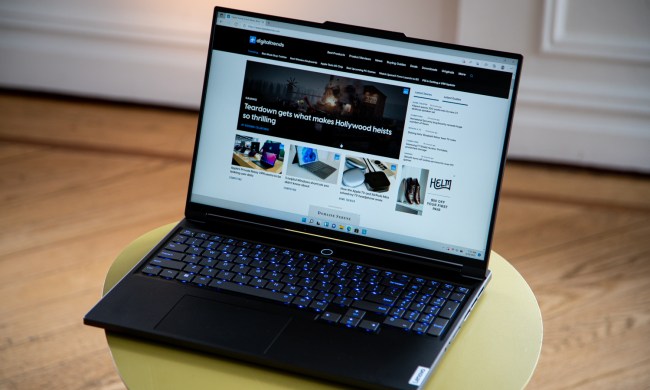“Lenovo’s U430 proves you don’t have to spend a fortune to enjoy a slim, powerful Ultrabook.”
- Good build quality and design
- Great keyboard
- 1600 x 900 display resolution
- Adequate performance
- Strong battery life
- Cool, quiet operation
- Touchpad feels cheap
- Dull display
- Speakers could be better
Chinese laptop manufacturer Lenovo has enjoyed a meteoric rise over the last few years, soaring from a mid-tier player to the world’s largest manufacturer. The company’s products have no doubt contributed to this, as they are almost always among the most affordable in any given category, yet they still maintain a satisfactory, and sometimes excellent, level of quality.
The Lenovo U430 Touch is powerful, attractive and inexpensive, making it one of the best budget Ultrabooks sold so far.
Lenovo’s more exotic Ultrabooks, like the Yoga, have become press darlings, but the company’s general excellence extends all the way down to its more basic and affordable systems. The U-series, for example, offers some of the most affordable Ultrabooks on the market, and the U310 earned our Editors’ Choice award in 2012.
Now we’ve been given a crack at its updated big brother, the U430 Touch. This 14-inch Ultrabook has a fourth-gen Intel processor, 4GB of RAM, and a 1600 x 900 display, yet it sells for just $699.
This once again puts Lenovo in a position to earn high marks through value, but the competition has stiffened since last year; the Acer has its inexpensive M5 and V7, Asus now has Vivobooks and even Zenbooks selling for $700 (or less), and Toshiba’s budget Satellites shouldn’t be forgotten. Does the U-series have what it takes best them all?
Simple, but sleek
Lenovo’s U-series has always been among the best-looking budget ultraportables, and the U430 Touch is no exception. Matte silver coats the display lid and interior, and the rear of the system swoops forward slightly, providing a hint of speed and luxury. A slight lip carved into the edges mimics an actual book, a touch carried over from now discontinued 12-inch U-series.
Build quality is high for the price, thanks to extensive use of thick metal, which offers both a luxurious feel and rigidity. Only a few components are plastic, and they are away from where users will normally touch. The broad display hinge does a good job of keeping the screen in place while the touchscreen is used, and the all-metal display lid resists flex very well.
Port options include three USB ports (two 2.0, one 3.0), HDMI, Ethernet, a combo headphone/microphone jack and a card reader. Though these connections are adequate, we prefer to see at least two USB 3.0 ports and two video outputs, traits some similarly priced-competitors offer.
A typical Lenovo keyboard
The U430’s AccuType keyboard feels about the same as it does on other IdeaPads, which is a compliment. Key travel is good and the layout is spacious, though it does slightly downsize the Backspace key to cram in a row of Home, End and Page Up/Down keys. Tactile feel suffers from a somewhat vague bottoming action, but the experience remains far above par.

The standard key backlighting is standard only has one brightness setting, but it’s dim enough to remain comfortable in a pitch-black room. Lenovo has also cured light-leak by fully recessing the keys into the chassis, rather than hovering just above. This provides no gap for unwanted light to escape.
The touchpad, though large, smooth and responsive, suffers from a hollow sound and cheap feel when the integrated left and right buttons are used. This is one area where the U430’s budget roots show, and it may annoy users who don’t pair this laptop with a mouse. Resorting to the touchscreen isn’t ideal because of this system’s size.
High resolution, low quality
All IdeaPad U430 Touch Ultrabooks come with a standard 1600 x 900 display.
In our tests this panel proved to be lackluster, as it only rendered 65 percent of the sRGB gamut and posted a contrast ratio of just 70:1. That’s thanks to poor black levels; the U430 can’t show anything deeper than a dark shade of gray.
Media content misses the punch and vibrancy a better display will provide and dark images often lack detail or suffer a hazy hue.
The display also suffers from poor viewing angles, particularly on the vertical axis. Maximum brightness is only average, but the glossy display is not quite as reflective as most, which means the U430 is usable in bright rooms.
Subjectively, these poor test scores translate to a washed-out look. Media content misses the punch and vibrancy a better display will provide and dark images often lack detail or suffer a hazy hue. With this said, however, we do think Lenovo deserves credit for making 1600 x 900 resolution standard. This creates a noticeably sharper image than the 1366 x 768 panels found on similarly priced competitors.
Audio quality is also below average. Maximum volume can’t overcome even moderate ambient noise, bass is all but absent, and sound staging is poor even by laptop standards. Buyers should plan on using headphones or speakers in all but the quietest rooms.
Basic Core i5 boasts strong performance
Our review unit arrived with a Core i5-4200U processor. This is one of the least-powerful Haswell chips, but it still provided decent performance, scoring 38 GOPs in the SiSoft Sandra Processor Arithmetic test and 5,812 MIPs in the 7-Zip benchmark. Both numbers are average for an Ultrabook at any price.
PCMark 8’s Creative test, which tests general system performance, came to a much less favorable score of 1,497. Most competitors score over 2,000, so the U430 lags the pack. Storage performance seems the main issue, as the storage score came to just 3,313, an average result at best.
While this system does use a solid state cache drive, it’s paired with a 500GB mechanical drive, and this combination just can’t keep up with systems with a larger SSD.
Intel HD 4600 graphics are the only option, and lead the U430 to a 3DMark Cloud Gate score of 3,253 and a Fire Strike score of 391. Both numbers are below par for a fourth-gen Intel laptop. Most games will work on this Ultrabook, but gamers shouldn’t expect to play demanding titles beyond low detail.
Haswell does it again
As a 14-inch Ultrabook, the U430 isn’t positioned as a super-light, all-day machine, yet it still managed very respectable results in our battery tests. The light-load Reader’s Test drained a full charge in eight hours and seven minutes, while the Peacekeeper Web browsing benchmark reduced that figure to a commendable six hours and three minutes.
At $699, this system is hard to beat.
Despite the strong results, our wattmeter found nothing special about the U430’s consumption. We recorded up to 14 watts of draw at idle and up to 26 watts at load. While the load figure is typical, the idle number is very high for an Ultrabook, and likely explains the laptop’s below-average performance in our low-load battery benchmark.
Keeping it quiet
The U430 is no powerhouse, but merely average performance in this case has an advantage; something close to silence. At idle, the system fan can be heard and even full load spike noise no higher than 43.1dB. That number is below-average and represents a fan quiet enough to be lost in a moderate ambient noise.
A lazy fan sometimes leads to excessive heat, but that’s not the case here. External temperatures did not exceed 88 degrees Fahrenheit at idle and only rose to 93.5 degree at load. This, once again, is a below-average result; many competitors warm to over 100 degrees at load.
Conclusion
Lenovo has managed to once again create budget Ultrabook magic with the Lenovo U430 Touch. At $699, this system is hard to beat, as it offers a decent display resolution, good keyboard, and adequate performance without sacrificing battery life.
This is not to say the U430 is perfect; it most certainly isn’t. The low-contrast display saps media content of life, the touchpad feels a bit cheap, and some competitors last longer on a charge. But consumers buying on a budget can’t have it all, and most other laptops in this price range make similar sacrifices. The $599 Zenbook, for example, can limbo so low because it uses 2nd-gen Intel Core hardware and downgrades the display to a similar 1600 x 900 panel.
We’ll stop short of saying this is the definitive 14-inch budget ultrabook. With competition so fierce, making such a call is difficult; a price drop of $50 can turn an also-ran into a top pick. At this very moment, however, the U430 is in a small group of inexpensive Ultrabooks worth buying over thicker, more traditional laptops.
Highs
- Good build quality and design
- Great keyboard
- 1600 x 900 display resolution
- Adequate performance
- Strong battery life
- Cool, quiet operation
Lows
- Touchpad feels cheap
- Dull display
- Speakers could be better








